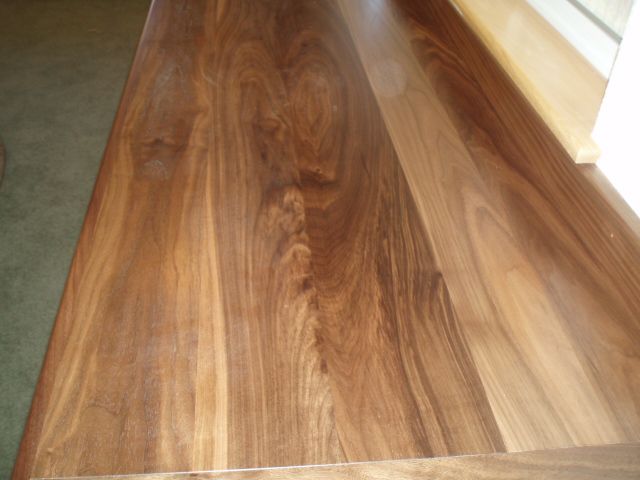Tips on Working with Walnut
A little advice for a cabinetmaker about to build a countertop using Walnut. October 11, 2012
Question
I have a rather large island countertop to make out of walnut (54" X 74"). I have never worked with walnut other than making the sample. Is there anything I need to know?
Forum Responses
(Cabinetmaking Forum)
From contributor B:
Standing in front of the island, are you going to glue up the boards vertical or horizontal?
From the original questioner:
74" is the length of the rip.
From contributor M:
I've just done small projects, but it machines well. Just be advised the sanding dust is quite irritating to many people's throat and lungs, some more than others. Use a dust mask/respirator!
From contributor J:
Steamed walnut looks like crap. Go for unsteamed.
From contributor H:
It's a wonderful wood, a pleasure to work with. The only thing I wish is that it could remain the great cafe au lait color it is before you finish it, but it can't, so sometimes I try to accompany it with a light-colored contrast wood, like maple or something, to make the piece sparkle a little more theatrically. Easy to walk by a dark walnut piece and not notice how beautiful it is.
From contributor I:
I agree about the dust. I hardly ever work with it but walnut and cedar are the only woods that I have to wear a mask with. The only thing that I have experienced with walnut that I didn't like is glue lines not looking so good. Several years ago I did a hearth for a fireplace and after the finish I could feel a small ridge of glue and the yellow glue showed up on the dark walnut. I might have done something wrong. It was when I first started and I've not worked with it since.
From contributor E:
Make sure you factor in high waste. Solid walnut can have a lot of defects. If you are only worried about one face, you might do well.
From contributor C:
Use
Titebond Dark Wood Glue. Usually solves the glue line problem.
From contributor R:
I wouldn't use any sapwood in a countertop, especially if there's a sink.
From contributor N:
I found that walnut is not as hard as I thought. I'd say it is about like cherry, but certainly not as hard as maple. It sanded fine and seamed up great and takes a finish beautifully.

Click here for higher quality, full size image
From contributor S:
With walnut, despite its great natural color, it is a good idea to use a wiping stain so that its original color will not lighten and wash out. This ruins the look of walnut eventually. The pigment in the stain will block a lot of the UV light which causes the problem. The correct stain will not eliminate the natural color variation which makes walnut look so great.
From contributor A:
Boos Block offers walnut as a standard species. You could by two 30x72 tops and joint and glue one seam. The cost would likely be less than you could buy the walnut for, and they warranty it. Can't beat it.
From the original questioner:
Two problems with the Boos idea.
1. Stock top is 72". I need it 74".
2. I priced it before I decided to build it myself… Hmm.
From Professor Gene Wengert, Sawing and Drying Forum technical advisor:
One point that has not been made is that liquid on walnut can dissolve some of the color (the color is water soluble partly), so you can get a color change. The coating must therefore be both heat resistant and liquid water resistant.
As mentioned, it is quite soft, so scratches and knife marks will develop quickly. There may be a desire by the owner to refinish the top every five years, so make sure the top is thick enough to handle sanding. In fact, you may want to make it more easily removable than you normally might.
From the original questioner:
Thanks Gene. What type of finish would you suggest? I was thinking just a wipe-on oil finish of some sort, or should I use a
polyurethane finish?
From Professor Gene Wengert, Sawing and Drying Forum technical advisor:
I am not an expert in finishes, so maybe posting to the Finishing Forum would be better. I would consider an oil finish, but test it out using a hot pan and some water to make sure it is adequate. If one is going to have food in contact with the surface, then food safety is also an issue.
From contributor A:
Finish choice all depends on whether or not they plan to cut directly on the surface or not. If not, I've had great success with General Finishes Enduro, waterbased cat urethane. I applied it by brush on site. It is totally impervious to water, coffee and red wine from what I can tell so far.
If a cutting surface is desired, I just use Mahoney's walnut oil, regularly. I offer to make the first knife mark since customers are often squeamish about that.
From contributor O:
Walnut wood and dust is rather toxic. One job won't kill you, but take care of exposure. Also, if by chance your shavings are collected by a horse owner for stall litter, separate the walnut out because it's very toxic to horses. They pee in it and the walnut mush is absorbed through their hooves. Another reason horses are a pain.
From Professor Gene Wengert, Sawing and Drying Forum technical advisor:
Walnut sawdust is also a mild herbicide, so do not put it on a garden.
